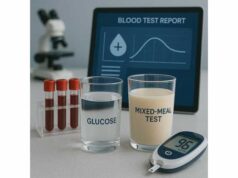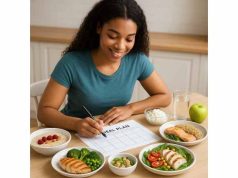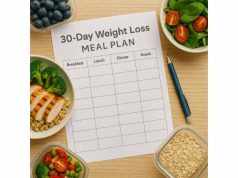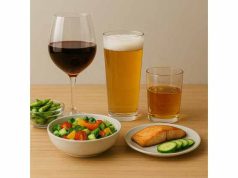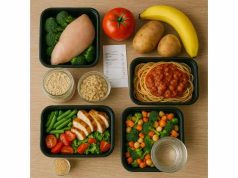
A weeknight dinner should do more than fill you up. If you are aiming to lose weight, the evening meal is your chance to hit a steady calorie target, get enough protein for muscle maintenance, and front-load fiber for appetite control. The 20 dinners below are fast, realistic, and built from ingredients you can find anywhere. Before you dive in, skim our concise framework for portions, simple cooking methods, and smart swaps. If you want the bigger picture on daily calorie targets, macro balance, and sample menus, see our guide to weight loss nutrition fundamentals. Then use the recipes to mix and match your week with minimal prep and maximum flavor.
Table of Contents
- High-protein, high-fiber dinners for weight loss
- How to build an easy weight loss dinner
- 20 easy dinner ideas
- Meal prep and time savers
- Common mistakes and fixes
- Special diets and swaps
- Evidence and quick facts
- Frequently Asked Questions
High-protein, high-fiber dinners for weight loss
When your dinner reliably delivers protein and fiber, three useful things happen: you feel satisfied on fewer calories, your blood glucose swings less overnight, and you recover better from daily activity or training. Protein has a high “thermic effect,” meaning it costs more energy to digest than carbs or fat, and it preserves lean mass while you are in a calorie deficit. Fiber increases meal volume and slows digestion, extending fullness into the evening without adding many calories.
A practical dinner target for most adults during weight loss is 400–600 calories, 25–40 grams of protein, and 8–15 grams of fiber. Hitting that range across the week matters more than perfection in any single meal. You can get there with a short list of foods: lean proteins (chicken, turkey, fish, tofu, tempeh, beans), high-fiber carbs (lentils, chickpeas, black beans, whole grains, potatoes with skin), and colorful produce (leafy greens, crucifers, peppers, tomatoes). Add small amounts of healthy fats (olive oil, nuts, avocado) for flavor and staying power.
Keep cooking methods simple: sheet-pan roasts, skillet sautés, air-fryer batches, pressure-cooker stews, or microwave-steamed sides. These methods produce consistent results and minimize cleanup on busy nights. If you prefer structure, build plates around a ½ vegetables, ¼ protein, ¼ quality carb pattern, then season assertively with citrus, herbs, spices, and umami boosters like miso or Parmesan.
If you are new to calorie control or want a step-by-step plan for pacing loss safely, start with our concise safe weight loss guide and then return here to plug in dinners that fit your numbers. The sections below show you how to assemble these meals quickly, then give you 20 ideas you can rotate for months without getting bored.
How to build an easy weight loss dinner
Use this repeatable template to hit protein and fiber targets without measuring every gram.
1) Pick your protein (25–40 g):
Choose one: 120–170 g cooked chicken or turkey; 120–150 g salmon or white fish; 170–200 g firm tofu or tempeh; 250 g Greek yogurt (2%–5%); or 1–1½ cups cooked beans or lentils. If your meal is vegetarian, combine plant proteins (e.g., tofu plus edamame, beans plus yogurt sauce) to reach the range.
2) Add a high-fiber carb (6–12 g fiber):
Choose one: ¾–1 cup cooked lentils or chickpeas; 1 cup black beans; ¾ cup cooked quinoa, farro, or barley; 1 medium baked potato or sweet potato (skin on); or 2 cups high-fiber pasta or zoodles with a bean-based sauce.
3) Fill half the plate with vegetables (2–6 g fiber):
Pile on 2 cups non-starchy vegetables: broccoli, Brussels sprouts, peppers, green beans, spinach, tomatoes, mushrooms, or a mixed salad. Roast, steam, sauté, or air-fry for speed and texture.
4) Add flavor, not bulk energy (100–150 calories):
Use 1–2 teaspoons olive oil, pesto, or toasted nuts; a crumble of feta or Parmesan; or creamy elements like tahini-lemon or yogurt-herb sauce. Citrus, vinegars, chili crisp, salsa, and spice blends add impact without many calories.
5) Check the range:
If your dinner is light on calories, add ½ cup extra beans or grains. If it is heavy, scale back the oil or cheese. Keep most dinners in the 400–600 calorie window for consistent progress.
6) Batch and repurpose:
Cook a double protein and grain on Sunday, then mix and match with different vegetables and sauces. A tray of roasted chicken thighs becomes tacos, salads, and grain bowls with almost no extra effort.
For more on selecting the right balance of protein, carbs, and fat for your goals, see our guide to macro ratios for fat loss.
20 easy dinner ideas
Below are 20 plug-and-play dinners designed for 400–600 calories, 25–40 g protein, and 8–15 g fiber per serving. Nutrition estimates are approximate and will vary with brands and portions, but each idea includes quick assembly notes and simple swaps.
- Sheet-pan lemon chicken with broccoli and chickpeas
Roast chicken breast strips, broccoli florets, and canned chickpeas with olive oil, garlic, and lemon. Finish with parsley.
Approx: 480 kcal, 38 g protein, 13 g fiber. - Salmon with warm lentil-tomato salad
Pan-sear salmon; toss cooked lentils with diced tomatoes, red onion, capers, and vinaigrette.
Approx: 520 kcal, 34 g protein, 12 g fiber. - Turkey chili with beans
Brown extra-lean turkey; simmer with kidney beans, crushed tomatoes, onion, and chili spices. Top with yogurt and scallions.
Approx: 500 kcal, 38 g protein, 14 g fiber. - Tofu and edamame stir-fry
Stir-fry firm tofu, shelled edamame, bell peppers, and snap peas in a garlic-ginger soy sauce. Serve over ¾ cup brown rice or cauliflower rice.
Approx: 540 kcal, 32 g protein, 11 g fiber. - Shrimp fajita bowls with quinoa and black beans
Sauté shrimp with fajita seasoning; serve over quinoa with black beans, peppers, onions, and salsa.
Approx: 510 kcal, 35 g protein, 13 g fiber. - Greek yogurt chicken salad pitas
Toss diced rotisserie chicken with Greek yogurt, celery, grapes, and dill. Stuff into whole-grain pita with romaine.
Approx: 460 kcal, 36 g protein, 10 g fiber. - Baked cod with white bean and tomato skillet
Roast cod; simmer cannellini beans with cherry tomatoes, garlic, and spinach in the same pan.
Approx: 440 kcal, 34 g protein, 12 g fiber. - Beef and mushroom lettuce wraps
Sauté extra-lean ground beef with mushrooms and water chestnuts; season with hoisin and lime. Serve in romaine leaves with shredded carrots.
Approx: 470 kcal, 34 g protein, 9 g fiber. - Vegetable frittata with white beans
Whisk eggs with chopped spinach, peppers, and onions; fold in white beans; bake until set. Side salad optional.
Approx: 430 kcal, 30 g protein, 8 g fiber. - Lentil bolognese over high-fiber pasta
Simmer red lentils with marinara, garlic, and basil; serve over 2 cups high-fiber spaghetti or zoodles.
Approx: 520 kcal, 28 g protein, 16 g fiber. - Chickpea and spinach curry
Simmer chickpeas and spinach in light coconut milk with curry paste; finish with lime. Serve over ½ cup brown rice.
Approx: 540 kcal, 20 g protein, 14 g fiber. - Tuna and cannellini bean salad bowls
Mix tuna in water with cannellini beans, cherry tomatoes, cucumber, olives, and lemon-olive oil dressing.
Approx: 480 kcal, 35 g protein, 12 g fiber. - Turkey meatballs with marinara and spaghetti
Bake lean turkey meatballs; serve over 1½ cups high-fiber spaghetti with marinara and Parmesan.
Approx: 560 kcal, 40 g protein, 13 g fiber. - Cottage cheese, roasted vegetables, and farro bowl
Top warm farro with roasted Brussels sprouts and carrots; add 1 cup cottage cheese and a drizzle of balsamic.
Approx: 520 kcal, 36 g protein, 11 g fiber. - Black bean and sweet potato enchilada bake
Layer roasted sweet potato cubes, black beans, salsa verde, and a light sprinkle of cheese; bake until bubbly.
Approx: 560 kcal, 24 g protein, 15 g fiber. - Air-fryer tofu with spicy cabbage slaw
Toss tofu cubes in cornstarch and spices; air-fry until crisp. Serve with cabbage slaw, avocado slices, and lime.
Approx: 500 kcal, 28 g protein, 12 g fiber. - Sardine avocado toast with salad
Mash sardines with lemon and Dijon; spread on whole-grain toast with avocado; serve with arugula salad.
Approx: 460 kcal, 27 g protein, 12 g fiber. - Chicken and soba stir-fry
Stir-fry sliced chicken thighs with broccoli and carrots; toss with cooked soba and sesame-ginger sauce.
Approx: 540 kcal, 36 g protein, 10 g fiber. - Tempeh tacos with pico and cabbage
Crumble tempeh with taco spices; pan-crisp and serve in corn tortillas with cabbage, pico de gallo, and yogurt crema.
Approx: 520 kcal, 30 g protein, 13 g fiber. - Garlicky shrimp and white beans with spinach
Sauté shrimp in olive oil with garlic and chili; fold in white beans and spinach; finish with lemon zest.
Approx: 480 kcal, 35 g protein, 11 g fiber.
Serving notes and quick swaps
- Add vegetables first if your plate looks small; volume helps you feel satisfied.
- Swap proteins freely: chicken ↔ turkey, cod ↔ tilapia, tofu ↔ tempeh, beans ↔ lentils.
- If you need fewer carbs at dinner, reduce grains by ¼–½ cup and boost vegetables.
- If you train in the evening, keep 30–60 g carbs to support recovery.
If you like full-week structure with grocery lists and leftovers planned in, see our 7-day high-protein plan.
Meal prep and time savers
Time is the biggest barrier to cooking when you are trying to lose weight. The solution is not complicated recipes—it is repeatable systems that compress prep, cooking, and cleanup.
Batch the bottlenecks
- Proteins (30–40 minutes once): Roast a tray of chicken thighs, press and air-fry two blocks of tofu, or simmer a pot of lentils. Keep in shallow containers for fast cooling and safe storage.
- Carbs (hands-off): Cook a pot of quinoa, barley, or brown rice; bake a sheet of potatoes or sweet potatoes; or use a rice cooker with a timer.
- Vegetables (10–15 minutes): Pre-cut hardy vegetables (broccoli, peppers, carrots) for three days. Leave delicate greens whole and wash just before eating to retain texture.
Build a “condiment bar”
Keep two flavor bases per week: salsa verde and tahini-lemon; chimichurri and yogurt-dill; or chili crisp and peanut-lime. Sauces turn the same base ingredients into Moroccan, Greek, or Southeast Asian-leaning meals without changing the macros much.
Choose appliances that do double duty
- Sheet pan for batch roasts and reheating.
- Cast-iron skillet for sear-to-oven meals.
- Pressure cooker for beans, chili, and steel-cut oats (for next day’s breakfast).
- Air fryer for crispy textures with minimal oil.
Default dinner formulas
- Grain bowl: ¼ cup sauce + ¾ cup grain + 1 cup veg + 120–170 g protein.
- Skillet stew: aromatics + 1 can tomatoes + 1–2 cans beans + 200–300 g protein + greens.
- Sheet-pan: 2 cups veg + 1 can legumes + 120–170 g protein + spices; roast 18–22 minutes at 220°C (425°F).
For a complete weekend blueprint that sets up four to five dinners in about an hour, try our one-hour weekend prep.
Common mistakes and fixes
Mistake 1: “Healthy” dinners that are low in protein
Grain-heavy bowls, vegetable pastas, and big salads can undershoot protein. Fix: Add 120–170 g chicken or fish, 170–200 g tofu/tempeh, or 1–1½ cups beans. Aim for at least 25 g protein per dinner; 30+ g is better for appetite control.
Mistake 2: Not enough fiber
You may hit calories and protein yet feel hungry later. Fix: Add a high-fiber carb and more vegetables: ½–1 cup beans, a potato with skin, ¾ cup barley or farro, plus 1–2 cups greens or crucifers.
Mistake 3: Too much “invisible” fat
Oil, nuts, cheese, and dressings add up quickly. Fix: Measure fats (teaspoons, not “glugs”), swap half the oil for broth or citrus, and rely on spices and acids for flavor. Keep most dinners to 1–2 teaspoons oil.
Mistake 4: Overcomplicated menus
New recipes every night burn time and willpower. Fix: Use a three-meal rotation per week. Repeat a favorite dinner twice and change the sauce or vegetable.
Mistake 5: Tiny dinners after tiny lunches
Under-eating earlier can backfire at night. Fix: Distribute protein across the day and include fiber at lunch. If evenings are hectic, batch-cook once and reheat.
If eyeballing portions is hard, our visual guide to smart portion sizes can help you regulate calories without weighing every bite.
Special diets and swaps
Vegetarian
Center dinners on beans, lentils, tofu, tempeh, seitan, and dairy or eggs if you use them. Combine plant proteins to reach 30–40 g: e.g., lentils + Greek yogurt sauce, tofu + edamame, or chickpeas + seitan. Keep fiber high with whole grains and vegetables; add nuts and oils in measured amounts.
Vegan
Tempeh, tofu, seitan, textured soy protein, edamame, and beans make it straightforward to hit protein goals. Use fortified plant milks and nutritional yeast for calcium and B12 (supplement if needed per your clinician). Favor bean-based pastas, high-fiber breads, and hearty vegetables for volume.
Gluten-free
Base carbs on potatoes, rice, quinoa, buckwheat, and corn tortillas. Many bean-based pastas are naturally gluten-free and bring extra protein and fiber to the plate.
Dairy-free
Rely on tahini, olive oil, avocado, and nut-based sauces for creaminess. Use miso, lemon, and nutritional yeast to replace the “cheesy” note in sauces.
Lower-carb evenings
If your appetite runs lower at night or you are cutting carbs then, keep protein high and swap grains for extra vegetables. Cauliflower rice, zucchini noodles, and roasted crucifers provide texture and fiber without large carbohydrate loads.
Higher-carb training days
After evening workouts, include 30–60 g carbs from potatoes, beans, or whole grains for glycogen replenishment and better sleep quality.
For seven days of meat-free, protein-forward dinners, see our vegetarian high-protein plan.
Evidence and quick facts
- Protein supports fullness and lean mass. Meals with 25–40 g protein boost satiety hormones and have a higher thermic cost of digestion, helping you maintain a calorie deficit while protecting muscle.
- Fiber extends fullness. Viscous and fermentable fibers (beans, lentils, oats, barley, veggies) add volume and slow gastric emptying. Adults benefit from 25–38 g fiber per day; dinners that supply 8–15 g make this target attainable.
- Even protein distribution works. Spreading protein across breakfast, lunch, and dinner is more effective for muscle maintenance than loading it all in one meal.
- Carbs are not the enemy. Quality carbs at dinner—especially beans, lentils, whole grains, and potatoes with skin—bring both fiber and potassium, supporting recovery and stable appetite.
- Simple cooking beats novelty. Sheet-pan, skillet, pressure-cooker, and air-fryer methods consistently hit the sweet spot of taste, texture, and time.
- Consistency drives results. A repeatable 400–600 calorie dinner pattern leads to steadier weight loss than sporadic “perfect” days followed by takeout rebounds.
Use these facts to calibrate—not complicate—your menu. Pick three dinners you like, shop once, and repeat next week with two changes to keep things fresh.
Frequently Asked Questions
What is a good calorie range for dinner when trying to lose weight?
Most people do well with 400–600 calories at dinner, depending on daily needs and activity. This range leaves room for a protein-rich breakfast and lunch while keeping total intake in a sustainable deficit, so hunger and energy stay more predictable across the week.
How much protein should dinner include for weight loss?
Aim for 25–40 grams. That level supports satiety and lean mass during a deficit. If you are smaller or less active, 25–30 g may be enough; larger or highly active adults often feel best around 35–40 g. Combine plant proteins if needed.
How much fiber should I get at dinner?
Target 8–15 grams from beans, lentils, whole grains, potatoes with skin, and vegetables. This helps you reach the daily 25–38 g goal without bloating. Increase fiber gradually and drink water to keep digestion comfortable.
Are carbs at dinner okay if I want to lose weight?
Yes. Choose high-fiber carbs like beans, lentils, whole grains, and potatoes with skin. They provide steady energy, potassium, and micronutrients. Keep portions modest (½–1 cup cooked) and pair with lean protein and vegetables to control calories and support fullness.
What if I am hungry after dinner?
First, check protein and fiber: did you hit 25–40 g protein and 8–15 g fiber? If not, add a small portion of Greek yogurt, cottage cheese, or vegetables with hummus. If you still feel hungry, consider whether lunch was too light or if your overall calorie target is too aggressive.
Can I eat dinner late at night and still lose weight?
Meal timing matters less than total daily intake and food quality. If evenings are late, keep dinners lighter, emphasize protein and fiber, and plan consistent breakfasts and lunches. Prioritize sleep; heavy, high-fat meals close to bedtime can disrupt rest for some people.
References
- Effects of Varying Protein Amounts and Types on Diet-Induced Thermogenesis: A Systematic Review and Meta-Analysis — 2024 (Systematic Review)
- Enhanced protein intake on maintaining muscle mass, strength, and physical function in adults with overweight/obesity: A systematic review and meta-analysis — 2024 (Systematic Review)
- Dietary fiber – a scoping review for Nordic Nutrition Recommendations 2023 — 2023 (Scoping Review)
- Dietary Guidelines for Americans, 2020–2025 — 2021 (Guideline)
- Protein Distribution and Muscle-Related Outcomes: Does the Evidence Support the Concept? — 2020 (Review)
Disclaimer
This article provides general nutrition information and is not a substitute for personalized medical advice. Always work with your healthcare provider if you have chronic conditions, take medications that affect appetite or blood sugar, are pregnant or breastfeeding, or have a history of eating disorders.
If this guide helped you: consider sharing it with a friend or family member who is planning healthier dinners. You are also welcome to follow us on Facebook, X, or any network you use for more practical nutrition tips and weekly menu ideas.

